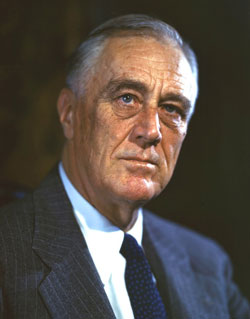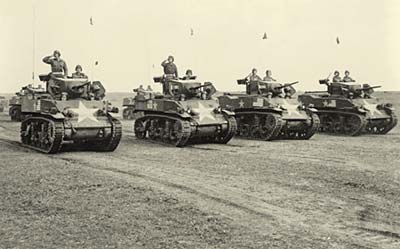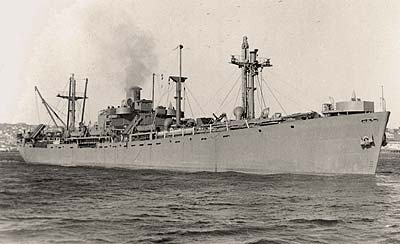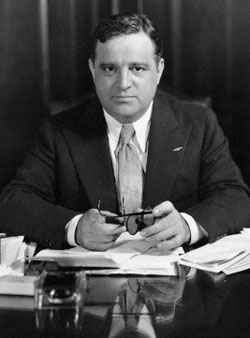Arsenal of Democracy
 President Franklin Roosevelt saw the need to mobilize for war early but struggled with setting up effective agencies. (Image courtesy Wikimedia)
President Franklin Roosevelt saw the need to mobilize for war early but struggled with setting up effective agencies. (Image courtesy Wikimedia)
As the situation in Europe rapidly deteriorated in the late 1930s, the Depression and isolationism held a firm grip on the economy and psyche of the United States. Meanwhile, President Roosevelt saw the need to hedge the nation's bet by calling for increased defense appropriations in 1938. Subsequent American defense increases as well as large British and French orders for military equipment helped to break the economic slumber of the Depression. By early 1941, driven by the dire situation in Europe, American factories were humming and great numbers of the
unemployed were back at work. The passage of the Lend-Lease Act gave the president broad discretion to transfer military, agricultural
and other goods to countries such as Britain, China
and the Soviet Union to further the defense of the United States. This advanced Roosevelt's goal of America doing "its full part in creating an adequate arsenal of democracy." (
 Listen to President Roosevelt's Fireside Chat on the arsenal of democracy
Listen to President Roosevelt's Fireside Chat on the arsenal of democracy dated 1940 - via youtube.com)
Mobilizing the Nation
Mobilizing America's government and economy to the needs of war before the attack on Pearl Harbor proved daunting, marked by fits and starts and
general disorganization. The passage of the Executive Reorganization Act of 1939 gave Roosevelt flexibility in creating agencies but resistance from isolationists and lack of expertise hampered efforts. The president experimented with creating bureaucracies such as the National Defense Advisory Commission and the Office of Production Management. But these bodies were ineffective at managing the complexities of mobilizing the nation and were not invested with clear leadership. In 1942, after weathering increasing criticism, Roosevelt established the War Production Board (WPB) with power to control and coordinate the national economy for the war effort. Some in the press claimed its new head, Donald M. Nelson, was about to "tackle the biggest job in all history." In a nod to the effectiveness of the new office, Nelson soon gained the unofficial title of "assistant president."
Footnote 1
Manufacturing Challenges
 Early in the war automobile factories started producing tanks and other war necessities instead of cars. (Image courtesy Library of Congress)
Early in the war automobile factories started producing tanks and other war necessities instead of cars. (Image courtesy Library of Congress)
The United States had tremendous production capability that was underutilized in the late 1930s. For example, automobile plants operated at only 50%. But many American manufacturers resisted conversion to war production. After a decade of economic depression, they wanted a piece of the reviving civilian production market (refrigerators, cars, vacuum cleaners) and they feared empty factories resulting from overexpansion and a boom-bust defense production cycle.
To entice participation, the government set up incentives for producing war goods and for converting, expanding, or building factories. Low-cost loans, tax write-offs, subsidies
and favorable depreciation regulations rewarded companies that cooperated. Particularly attractive were "cost-plus" contracts that guaranteed companies the cost of production plus a fixed profit, essentially wiping out the risk. The federal government also invested billions of dollars in building new factories that were then leased to private
companies at
low rates. One estimate pegged government financing for industrial expansion at over 65% from 1940 to 1943.
Footnote 2
While incentives helped, Pearl Harbor and the declaration of war soon brought about further changes in government and new imperatives to manufacturers. Nelson's WPB got the authority to commandeer materials and prioritize their use, force the conversion and expansion of factories, and ban the production of "nonessential" goods. Soon, items such as refrigerators, bicycles and waffle irons were largely out of production for the duration of the war. In an even bigger hit to civilian life, automobile production plants were converted to the production of jeeps, airplanes, tanks, guns
and other war products. Still, for all of the inconvenience, the conversion to war production was critical as Soviet dictator Joseph Stalin noted: "The most important things in this war are machines, and the United States is a country of machines."
Research and Innovation Prove Crucial
 Liberty ships, such as the SS Joseph Henry built at Kaiser shipyards in the Portland area, benefited from new mass-production techniques that drastically reduced build time. (Image courtesy Smithsonian Institution)
Liberty ships, such as the SS Joseph Henry built at Kaiser shipyards in the Portland area, benefited from new mass-production techniques that drastically reduced build time. (Image courtesy Smithsonian Institution)
As government ramped up production numbers to respond to the growing need, it couldn't ignore issues related to quality and innovation. After a slow start in which American products such as fighter planes and tanks failed to match those of the enemy, improved design and construction techniques leveled the quality playing field, making sheer numbers more decisive. Before Pearl Harbor, Roosevelt set up government science research and development offices that eventually led to major advances in atomic energy, radar, and synthetic rubber - all critical to the war effort.
Synthetic rubber, for example, proved the importance of the research. In 1942 Japan quickly dominated Southeast Asia, cutting off the supply of about 90% of America's crude rubber supply. While rationing and salvage helped the military tread water with existing supplies, researchers worked feverishly to synthesize rubber in the laboratory. The efforts paid off by late 1942 and the government quickly poured $700 million into the building of 51 synthetic rubber production plants. By 1944 synthetic rubber accounted for nearly 90% of the total used. Shipbuilding saw similar successes, this time by using new mass-production techniques. In 1941 it took about a year to build the transport Liberty Ships. By 1942 Portland's Kaiser shipyards had cut the time to two months and by 1944 the time was reduced to an amazing two weeks.
Footnote 3
Organizing the Home Front Effort
 Colorful New York Mayor Fiorello La Guardia was not the right man to lead the federal Office of Civilian Defense. He was replaced in 1942 by the steadier Harvard Law School Dean James M. Landis. (Image courtesy Wikimedia)
Colorful New York Mayor Fiorello La Guardia was not the right man to lead the federal Office of Civilian Defense. He was replaced in 1942 by the steadier Harvard Law School Dean James M. Landis. (Image courtesy Wikimedia)
The War Production Board played an important role in mobilization for war, but it was not
the only player. The growing thicket of federal agencies included a mind-boggling array of abbreviations: for example, the OPA (Office of Price Administration), the OWI (Office of War Information), and the OCD (Office of Civilian Defense). Roosevelt set up the OCD in the spring of 1941 with the goal of channeling the efforts of the American population on the home front into needed work ranging from conducting air raid drills to salvaging scrap metal.
First headed by the dynamic and colorful New York Mayor Fiorello La Guardia, the OCD focused primarily on civilian protection, which sharpened even more after the Pearl Harbor attack brought the possibility of invasion more clearly to the imaginations of Americans. Unfortunately, La Guardia was miscast in his role. He only served part time in a job that was massive in its demands. And, he showed little interest in organizing volunteers, a key need for the OCD. Eventually his critics, including First Lady Eleanor Roosevelt, managed to oust him in early 1942 in favor of the methodical James M. Landis. By 1943 as the fears of enemy attack lessened somewhat, the war services role of the Office of Civilian Defense took on more prominence. Organizationally, the OCD set up offices based on regions and sectors with San Francisco as the west coast headquarters and Seattle anchoring the Pacific Northwest. It also encouraged states to form defense councils. Oregon Governor Charles A. Sprague eventually responded and formed the Oregon State Defense Council by executive order in June 1941.
Further discussion of mobilization related to civilian protection, war services, morale, and other aspects of the war effort are included throughout this exhibit.
Notes